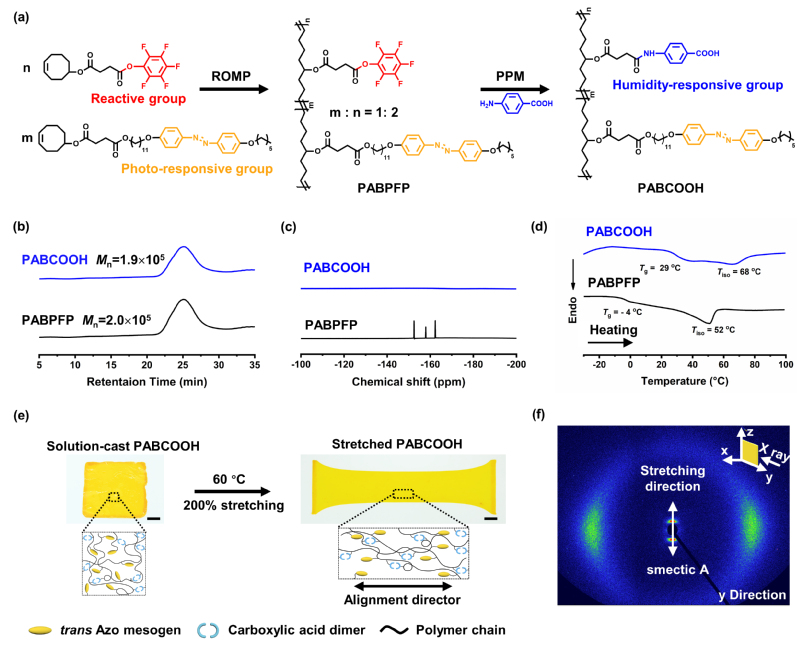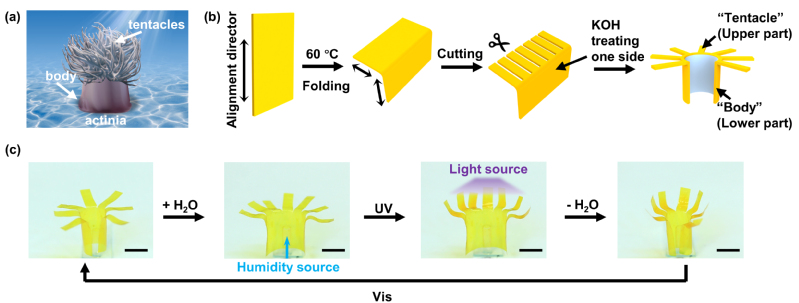Search
In smart materials, the specific molecular arrangement and liquid crystal phase structure of liquid crystal polymers (LCPs) endow the molecular synergistic effect and anisotropy, which greatly improves the stimulus responsivity of the materials, and LCPs have been demonstrated as ideal candidates for achieving multi-responsive deformation. Post-Polymerization Modification (PPM) is designed to perform efficient functional modification on reactive polymer precursors with mild reaction conditions to avoid the interference between the functional groups and the polymerization process, as well as providing tremendous convenience for the preparation of multifunctional polymers. The preparation of stimuli-responsive deformable LCPs by PPM has been reported, but PPM has mostly been used for post-crosslinking reaction and has not been fully employed for the preparation of multi-responsive deformable LCPs.
Recently, our group has designed a facile synthetic approach towards multifunctional LCP by combining the ring-opening metathesis polymerization (ROMP) with PPM (Fig. 1a), in which ROMP helps to prepare a reactive LCP precursor PABPFP with high molecular weight, good mechanical strength without crosslinking (Fig. 1b), and PPM provides a great facilitation to introduce functional groups. Based on this universal strategy, our team prepared a recyclable photo- and humidity-responsive linear LCP (PABCOOH) film with good liquid crystal orientation via mechanical hot-stretching (Fig. 1e, f).

Figure 1. a) Synthetic route of the reactive LCP precursor and the dual-responsive linear LCP. b-d) Gel Permeation Chromatography (GPC) curves, 19F NMR spectra and DSC curves of obtained linear LCPs. e) Schematic illustrations of the preparation of the stretched linear LCP film via hot-stretching process. f) 2D-XRD patterns of the linear LCP film with smectic A phase.
Under UV irradiation, the film bent along the direction of mesogen alignment due to the azobenzene molecules on the surface changed from trans isomers to cis isomers, and the cis isomers could return to trans isomers under visible light irradiation, making the film return to the flat state. In addition, carboxylic acid groups in the film mainly existed in the form of acidic dimers with hydrogen bonding interactions. After base treatment, the hydrogen bond network was destroyed and transformed into hygroscopic carboxylic salt. When the relative humidity of the environment increases, the film could absorb water and bend along the direction perpendicular to the mesogen alignment.
Thanks to the linear structure of the obtained LCP, we have successfully realized three-dimensional shaping and recycling processes. And then we fabricated the bionic “actinia” three-dimensional actuator by folding and cutting, and demonstrated its anisotropic deformation behavior under the stimulation of UV light and humidity changes. This synthetic strategy provides a facile platform for obtaining multi-stimuli responsive materials, and contributes to the construction of bionic three-dimensional actuators with multifunctional and controllable deformation direction, as well as its potential applications in intelligent soft robots and other fields.

Figure 2. a) Scheme of an actinia with the body and tentacles indicated by white arrows. b) Schematic illustration of fabricating process of an artificial actinia. c) The programmable deformation of an artificial actinia under different stimuli.
The research results were recently published as Hot Paper in Angew. Chem. Int. Ed., 2023, e202300699.
Fulltext Link: https://onlinelibrary.wiley.com/doi/10.1002/anie.202300699







